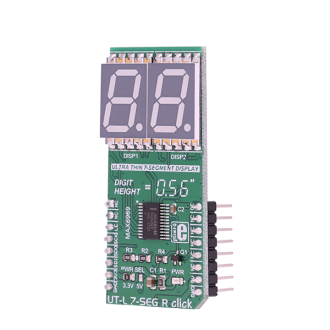
We strongly encourage users to use Package manager for sharing their code on Libstock website, because it boosts your efficiency and leaves the end user with no room for error. [more info]

Rating:
Author: MIKROE
Last Updated: 2018-06-14
Package Version: 1.0.0.1
mikroSDK Library: 1.0.0.0
Category: LED segment
Downloaded: 6347 times
Not followed.
License: MIT license
UT-L 7-SEG R click carries two SMD ultra thin (3.1mm) LED 7-SEG displays and the MAX6969 constant-current LED driver from Maxim Integrated. The click is designed to run on either 3.3V or 5V power supply. It communicates with the target microcontroller over SPI interface.
Do you want to subscribe in order to receive notifications regarding "UT-L 7-SEG R click" changes.
Do you want to unsubscribe in order to stop receiving notifications regarding "UT-L 7-SEG R click" changes.
Do you want to report abuse regarding "UT-L 7-SEG R click".
